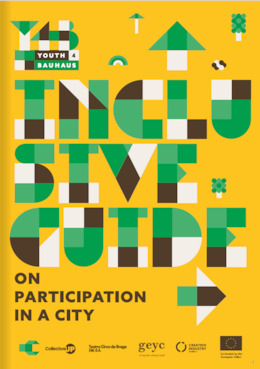Toolbox — For Training and Youth Work
All new tools in your inbox: Be the first to know about new tools for learning with our e-mail notifications.
Manual
Inclusive Guide on Participation in a City
The Inclusive Guide, publication stemming from the Youth 4 Bauhaus project, serves as a powerful tool to the pivotal role of inclusivity in envisioning and shaping cities that truly embrace diversity.
Aims of the tool
The Inclusive Guide asserts that the built environment must transcend physical structures; it should foster a sense of ownership among individuals, regardless of age, ability, or sexual orientation. By recognizing and addressing the distinct expectations and requirements of various demographics, from streets to parks and rivers, the guide becomes a catalyst for social cohesion. It strives not only to build spaces but to construct a shared sense of belonging and identity within communities and neighborhoods.
The guide serves as a reflection of the project partners‘ findings while working with diverse groups of youth on city co-creation implementing the principles of New European Bauhaus.
Its aim is to provide insights on the project activities and the challenges brought up, the solutions and the results for evaluation collected immediately after the event.
Description of the tool
The Inclusive Guide emerges as a beacon of change, focusing on empowering young people in decision making processes related to public space planning. The Inclusive Guide is a roadmap towards cities that are not just functional, but compassionate, ensuring that no voice is unheard, and no citizen is left behind in the pursuit of progress.
The Inclusive Guide‘s alignment with the New European Bauhaus (NEB) further underscores its importance. In 2020, the president of the European Commission launched the NEB, envisioning it as a transformative initiative built on the pillars of aesthetics, sustainability, and inclusivity. By embracing these principles, the Inclusive Guide echoes the NEB‘s vision and, in turn, contributes to a more holistic and trans-sectoral approach to urban development.
This publication (in English, Slovak, Romanian, Dutch, and Portuguese) and further publications and tools produced in the project can be downloaded free of charge at: https://www.cike.sk/en/project/youth-4-bauhaus-en/
Available downloads:
Disclaimer
SALTO cannot be held responsible for the inappropriate use of these training tools. Always adapt training tools to your aims, context, target group and to your own skills! These tools have been used in a variety of formats and situations. Please notify SALTO should you know about the origin of or copyright on this tool.
Tool overview

http://toolbox.salto-youth.net/4295
This tool is for
Young People and Youth Workers: The primary audience is youth, as the guide emphasizes empowering young people in decision-making processes related to public space planning. Urban Planners and Architects: Professionals involved in city planning and architectural design who are interested in integrating inclusivity and diversity into their projects. Community Leaders and Local Governments: Individuals and organizations responsible for the development and management of public spaces. Advocates for Inclusivity and Diversity: Activists, NGOs, and other groups advocating for more inclusive and equitable urban environments. The guide serves as a tool to support their efforts and provide evidence-based recommendations for inclusive design. Educators and Researchers: Academics and students in fields related to urban studies, architecture, and social sciences who are interested in the intersection of inclusivity, diversity, and urban planning.
and addresses
Social Inclusion, Disability, Organisational Management, Youth Participation, Environment
Behind the tool
The tool was created by
This publication has been written by consortium of partners in Erasmus + project Youth 4 Bauhaus. This consortium includes: Liliana Carrillo, Frederick Ducatelle (CollectiveUP), Loredana Bucseneanu, Paul Fen
in the context of
This publication has been written under the umbrella of the Erasmus + project Youth 4 Bauhaus, project ID: 2021-2-SK02-KA220-YOU-000050748, which aims to build capacity of organizations to use innovative approaches to empower and engage young people to
The tool was published to the Toolbox by
Ana-Maria Todoran (on 8 July 2024)
and last modified
2 July 2024
Comments
No comments have been posted yet.
If you want to comment on this tool, you need to be signed in with your MySALTO account. Sign in now